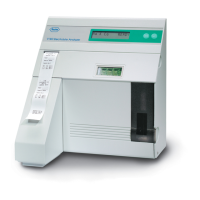viii
Dialysate Electrolytes
In the dialyzer, arterial blood and suitable dialysate liquids are led to a dialysis membrane in opposite
directions. The structure of the membrane is such that it prevents the diffusion of proteins and red
blood cells through the membrane. Since the composition of the blood and the dialysate are different,
a gradient will be formed at the membrane and thus smaller molecules are activated to diffuse
through the membrane. This method is effectively used to remove substances like urea, uric acid
which are unable to excrete from the blood because of renal insufficiency.
When the concentration of the electrolytes between the blood and dialysate liquid deviates signifi-
cantly, the electrolytes diffuse in the direction towards the lower concentration (i.e. from blood into
the dialysis liquid or vice versa). Analysis of electrolytes in dialysis is of immense clinical signifi-
cance and provides useful information to the clinician. The use of ISE's in dialysis are:
To control the patient's electrolyte balance before, during and after the dialysis for fast
recognition of deviations and also for making early corrections.
To control the electrolyte concentrations in the dialysis liquid. Normally they are prepared
by mixing appropriate concentrations of the substances with a defined quantity of distilled
water.
Principles of Procedures
The AVL 9180 Analyzer methodology is based on the ion-selective electrode (ISE) measurement
principle to precisely determine the measurement values.
There are six different electrodes used in the AVL 9180 Electrolyte Analyzer: sodium, potassium,
chloride, ionized calcium, lithium and a reference electrode. Each electrode has an ion-selective
membrane that undergoes a specific reaction with the corresponding ions contained in the sample
being analyzed. The membrane is an ion exchanger, reacting to the electrical charge of the ion
causing a change in the membrane potential, or measuring voltage, which is built up in the film
between the sample and the membrane.
A galvanic measuring chain within the electrode determines the difference between the two potential
values on either side of the membrane. The galvanic chain is closed through the sample on one side
by the reference electrode, reference electrolyte and the "open terminal". The membrane, inner
electrolyte and inner electrode close the other side.
A difference in ion concentrations between the inner electrolyte and the sample causes an electro-
chemical potential to form across the membrane of the active electrode. The potential is conducted
by a highly conductive, inner electrode to an amplifier. The reference electrode is connected to
ground as well as to the amplifier.
The ion concentration in the sample is then determined by using a calibration curve determined by
measured points of standard solutions with precisely known ion concentrations.

